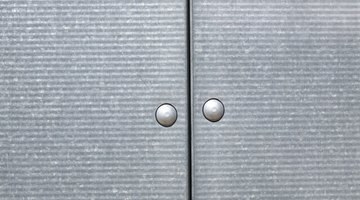How to Clean Oxidized Aluminum
Aluminum appears throughout the home, from kitchen fixtures and accessories to exterior decorative features. As a durable, affordable and noncorrosive metal, aluminum's popularity is little wonder. Over time, the process of oxidation causes a milky, dull, chalky coating to appear on aluminum.

When oxidation rears its ugly head, turn to common household items to restore your aluminum's subtle sheen.
Things You Will Need
- Mild dish detergent
- Nylon-bristled brush or stainless steel wire brush
- Cellulose sponge
- Aluminum etching cleaner
- Steel wool, grade 0000 or 000
- Neoprene gloves
- Microfiber cloth
- Denatured alcohol
Tip
Before cleaning any aluminum items or surfaces in your home, consult the manufacturer's recommendations for maintenance. If cleaning outdoor aluminum, avoid working under direct sunlight -- the sun may dry the detergent, leading to streaks or residue. If the aluminum suffers from heavy oxidation and household detergent doesn't do the trick, try a specialized aluminum cleaner or oxide removal solution. Always read and follow the manufacturer's instructions and warnings when using these heavy-duty cleaners. Consider applying a protective aluminum coating, available at hardware and home improvement stores, to outdoor anodized aluminum after cleaning. These products help aluminum maintain its luster and prevent fading and oxidation. Remove oxidation from aluminum pots by filling them with a mixture of 1 liter of water and 2 tablespoons of cream of tarter and boiling the solution for about 10 minutes before rinsing the pot clean. Wash aluminum exterior siding with a pressure washer set to low pressure. Try plain water first -- if it doesn't do the trick, scrub the siding with a biodegradable detergent or trisodium phosphate before giving it a spray.
Warning
Avoid using chemical cleaners on aluminum cookware or other items used in cooking and dining.
-
Clear debris from the surface of the aluminum with a soft nylon-bristled brush or, for bare aluminum, a stainless steel wire brush, to prepare the metal for cleaning.
-
Combine mild dish detergent with clean water, using about1/4 pint of soap per gallon of water.
-
Dip a cellulose sponge into the solution and scrub the surface of the oxidized aluminum, applying moderate pressure and making even strokes. Wring and rinse the sponge, and then use it to rinse the aluminum clear of detergent. Allow it to air-dry. Rinse thoroughly, and do not allow any detergent to dry onto the aluminum.
-
Apply aluminum etching cleaner with stainless steel wool, grade 0000 to 000, if the dish detergent and water mixture does not remove the oxidation. Use only stainless steel wool, and apply etching cleaner only to bare aluminum. Wear neoprene gloves when applying these acidic cleaners. Rinse away the cleaner with clean water and a cellulose sponge. Allow the aluminum to air-dry completely.
-
Give the aluminum a final once-over with a microfiber cloth dampened with denatured alcohol to remove residue and fingerprints.
The Drip Cap
- Aluminum appears throughout the home, from kitchen fixtures and accessories to exterior decorative features.
- Apply aluminum etching cleaner with stainless steel wool, grade 0000 to 000, if the dish detergent and water mixture does not remove the oxidation.
- Give the aluminum a final once-over with a microfiber cloth dampened with denatured alcohol to remove residue and fingerprints.
References
- Everbrite Coatings: How to Refurbish Oxidized Anodized Aluminum
- Everbrite Coatings: How to Clean and Refurbish Oxidized or Sun-Faded Anodized Aluminum, Painted or Powder Coated Window Frames
- Everbrite Coatings: Stucco or Mortar Can Stain and Ruin the Finish of Aluminum. Aluminum Window Frames Can Be Restored with Everbrite
- Lincoln Electric: The Best Way to Clean Aluminum Before Welding?
- Reader's Digest: 20+ Ways to Easily Clean Pots and Pans
Resources
Writer Bio
Dan combines his decade-long experience as a freelance writer with hands-on experience in landscaping, flooring, painting, maritime maintenance and handy man work. Previously, he's published with Black+Decker, Geeks On Home, GardenGuides.com, GOBankingRates.com, USA Today, SFGate Home and others.
Photo Credits
- Thinkstock/Stockbyte/Getty Images
- Thinkstock/Stockbyte/Getty Images
More Articles



